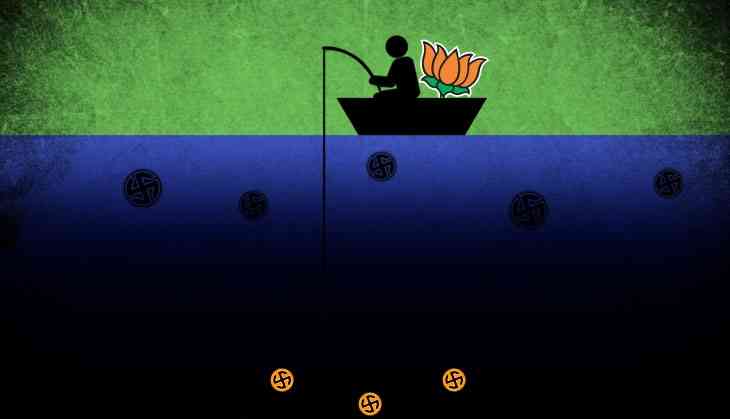Is the new OBC commission part of Modi's grand plan for Lok Sabha elections?

There is a heavy political significance in the Narendra Modi government’s decision to appoint a five-member commission to examine sub-categorisation of Other Backward Classes (OBC). The ultimate objective could be a grand plan to create a new vote bank for the BJP, which will bring to the party, Assembly as well Parliamentary, seats in areas where it is not strong presently.
According to the official release (http://pib.nic.in/newsite/printrelease.aspx?relid=171331), this decision will “ensure more backwards among OBC communities get benefits of reservation”. That essentially translates into – a reach-out to those communities in the central OBC list who have not been able to reap benefits of reservation as much as the dominant OBCs.
The significance of that lies in the hold the regional parties, born out of the Mandal movement, have among the dominant OBCs almost across the country. If greater quota benefits are announced for the non-dominant ones, the BJP will count on that to consolidate their allegiance and break the monopoly of the dominant OBC parties, simultaneously.
In the OBC pool of every state, there are two to three dominant communities that are large in numbers and have lorded over the benefits of reservations over decades. This has also brought political power to them and led to the rise of regional parties like the Samajwadi Party and Rashtriya Janata Dal and regional leaders like Mulayam Singh Yadav, Lalu Prasad, Nitish Kumar, late Gopinath Munde and many others.
However, this has happened at the cost of hundreds of other smaller communities who are also categorised as OBC but lack clout owing to their numerical weakness.
The BJP has for long been trying to reach out to these communities because wherever Mandal parties have been strong, the party has found it difficult to make inroads. The new OBC commission is an effort to make sure that changes.
Sanjay Kumar, Director of the New Delhi-based Centre for the Study of Developing Societies, told Catch that this game plan can be better understood by looking at Bihar, for example.
Kumar explained that only three communities are dominant in the state's OBC landscape – Yadavs, Kurmis and Koeris – because of their large population. If one leaves them out, there are anywhere between 100-150 other smaller communities within the larger OBC fold, whose individual population is small but together, they are a large bloc. These include dhobis, naais, kahaars, kumhaars, kevats and many others.
Chief Minister Nitish Kumar turned them into his vote-bank by granting them an official status of Extremely Backward Communities and crafting separate quotas for them. Sanjay Kumar said these communities showed an increased preference for the BJP in 2014 Lok Sabha elections and the party now wants to consolidate these gains for the next round of polls.
A similar situation exists in Uttar Pradesh. Lucknow-based political analyst Ramesh Dixit informed that Yadavs and Kurmis are the dominant OBC groups and they are already committed to the Samajwadi Party and some caste leaders who have been with multiple outfits.
However, others like rajbhars, nishads, kevats etc were open for pursuit and the BJP has been successfully reaching out to them, according to Dixit.
In fact, getting the support of the nearly 200 such non-dominant OBCs in the state was the BJP's big social-engineering feat in the run-up to the latest Assembly polls and it paid off for the party, Dixit explained
Professor Gurpreet Mahajan, Professor at Centre for Political Studies, Jawaharlal Nehru University, sees one key political objective behind the setting up of this commission.
The BJP might be wanting to reach out to new groups that have been demanding quotas of late, like the Marathas. Maharashtra has seen huge rallies organised by Marathas to press for their demand of quotas. Similar muscle force has been demonstrated by Jats in Haryana, Gujjars in Rajasthan, Patidars in Gujarat and Kapus in Andhra Pradesh, demanding inclusion in the OBC list and quotas.
Shashi Bhushan, former senior fellow at Patna-based AN Sinha Institute for Social Studies, puts the nation-wide situation in perspective. He estimates OBCs at nearly 52% of the total population of the country and among them, an overwhelming number of 31-32% are non-dominant groupings. That's a huge constituency to reach out to and a huge potential vote-bank.
Bhushan also believes that this initiative will also enable the BJP to get rid of an old albatross around its neck, of being perceived as a Savarna party that is out to destroy the reservation system. It may be recalled how a spin to this effect given by RJD supremo Lalu Prasad Yadav to a remark by RSS chief Mohan Bhagwat cost the BJP the Bihar Assembly polls in 2015.
Actual fruits of this exercise will emerge only after the Commission submits its report and its recommendations get implemented. Something which is not clear so far is – will the Commission be given access to the caste data of Census 2011, which has not been made public so far?
If the Commission doesn't get that data, it will be forced to conduct its own enumeration exercise. In that case, it will be nearly impossible for it to stick to the deadline of twelve weeks that it has been given.
Edited by Jhinuk Sen


